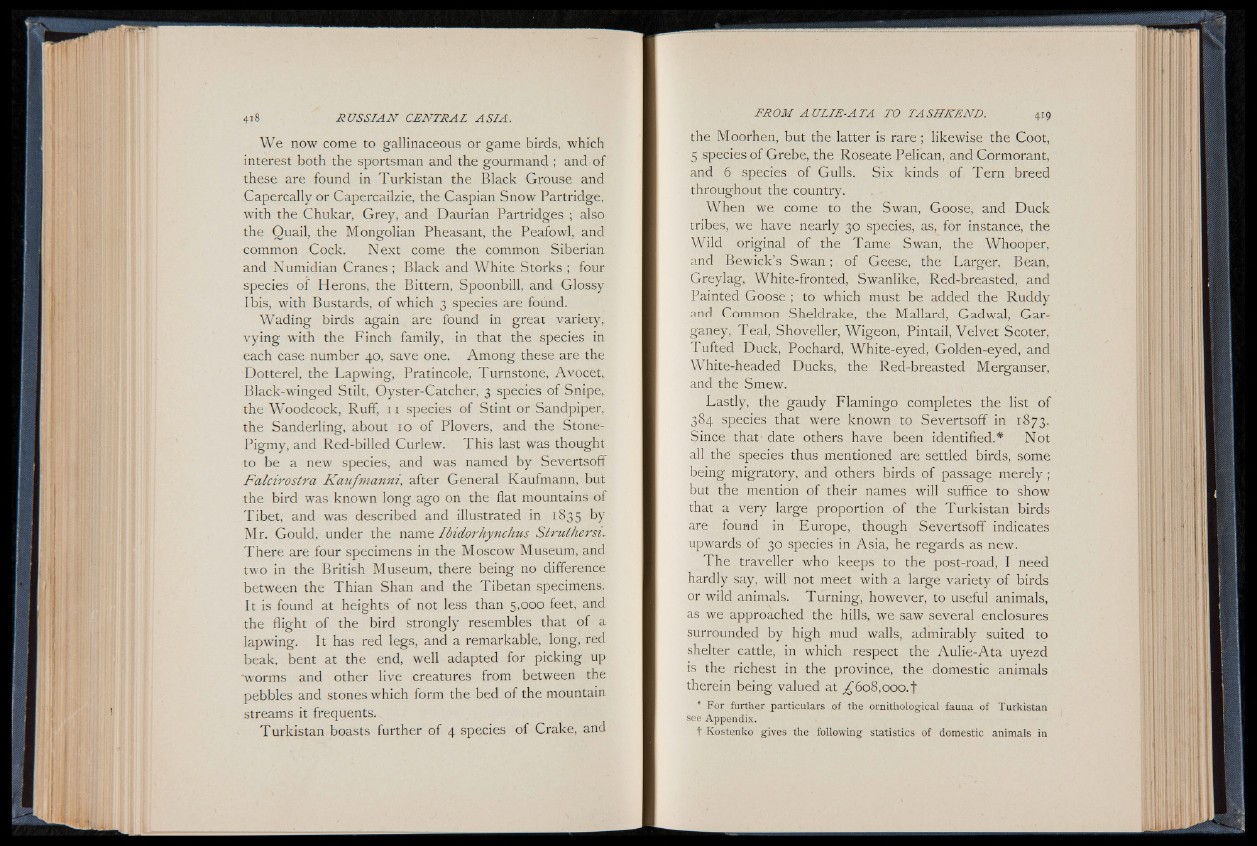
We now come to gallinaceous or game birds, which
interest both the sportsman and the gourmand ; and of
these are found in Turkistan the Black Grouse and
Capercally or Capercailzie, the Caspian Snow Partridge,
with the Chukar, Grey, and Daurian Partridges ; also
the Quail, the Mongolian Pheasant, the Peafowl, and
common Cock. Next come the common Siberian
and Numidian Cranes ; Black and White Storks ; four
species of Herons, the Bittern, Spoonbill, and Glossy
Ibis, with Bustards, of which 3 species are found.
Wading birds again are found in great variety,
vying with the Finch family, in that the species in
each case number 40, save one. Among these are the
Dotterel, the Lapwing, Pratincole, Turnstone, Avocet,
Black-winged Stilt, Oyster-Catcher, 3 species of Snipe,
the Woodcock, Ruff, 11 species of Stint or Sandpiper,
the Sanderling, about 10 of Plovers, and the Stone-
Pigmy, and Red-billed Curlew. This last was thought
to be a new species, and was named by Severtsoff
Falcirostra Kaufmanni, after General Kaufmann, but
the bird was known long ago on the flat mountains of
Tibet, and was described and illustrated in 1835 by
Mr. Gould, under the name Ibidorhynchus Struthersi.
There are four specimens in the Moscow Museum, and
two in the British Museum, there being no difference
between the Thian Shan and the Tibetan specimens.
It is found at heights of not less than 5,000 feet, and
the flight of the bird strongly resembles that of a
lapwing. It has red legs, and a remarkable, long, red
beak, bent at the end, well adapted for picking up
•worms and other live creatures from between the
pebbles and stones which form the bed of the mountain
streams it frequents.
Turkistan boasts further of 4 species of Crake, and
the Moorhen, but the latter is rare ; likewise the Coot,
5 species o f Grebe, the Roseate Pelican, and Cormorant,
and 6 species of Gulls. Six kinds of Tern breed
throughout the country.
When we come to the Swan, Goose, and Duck
tribes, we have nearly 30 species, as, for instance, the
Wild original of the Tame Swan, the Whooper,
and Bewick’s Swan ; of Geese, the Larger, Bean,
Greylag, White-fronted, Swanlike, Red-breasted, and
Painted Goose ; to which must be added the Ruddy
and Common Sheldrake, the Mallard, Gadwal, Gar-
ganey, Teal, Shoveller, Wigeon, Pintail, Velvet Scoter,
Tufted Duck, Pochard, White-eyed, Golden-eyed, and
White-headed Ducks, the Red-breasted Merganser,
and the Smew.
Lastly, the gaudy Flamingo completes the list of
384 species that were known to Severtsoff in 1873.
Since that- date others have been identified.* Not
all thé species thus mentioned are settled birds, some
being migratory, and others birds of passage merely ;
but the mention of their names will suffice to show
that a very large proportion of the Turkistan birds
are found in Europe, though Severtsoff indicates
upwards, of 30 species in Asia, he regards as new.
The traveller who keeps to the post-road, I need
hardly say, will not meet with a large variety of birds
or wild animals. Turning, however, to useful animals,
as we approached the hills, we saw several enclosures
surrounded by high mud walls, admirably suited to
shelter cattle, in which respect the Aulie-Ata uyezd
is the richest in the province, the domestic animals
therein being valued at ^6o8,ooo.t
* For further particulars of the ornithological fauna of Turkistan
see Appendix.
t Kostenko gives the following statistics of domestic animals in